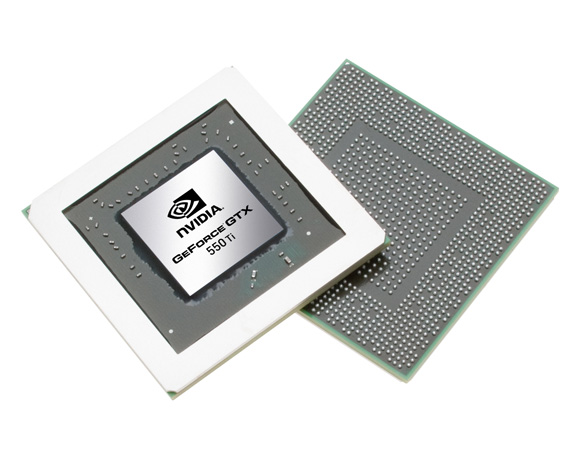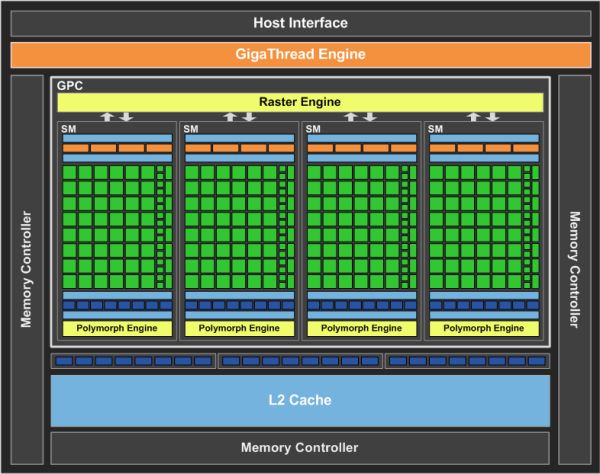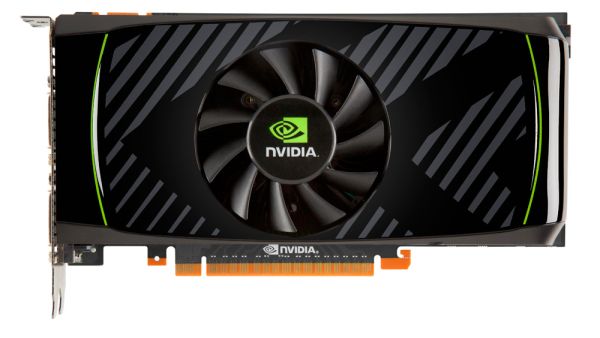NVIDIA's GeForce GTX 550 Ti: Coming Up Short At $150
by Ryan Smith on March 15, 2011 9:00 AM ESTThroughout the lifetime of the 400 series, NVIDIA launched 4 GPUs: GF100, GF104, GF106, and GF108. Launched in that respective order, they became the GTX 480, GTX 460, GTS 450, and GT 430. One of the interesting things from the resulting products was that with the exception of the GT 430, NVIDIA launched each product with a less than fully populated GPU, shipping with different configurations of disabled shaders, ROPs, and memory controllers. NVIDIA has never fully opened up on why this is – be it for technical or competitive reasons – but ultimately GF100/GF104/GF106 never had the chance to fully spread their wings as 400 series parts.
It’s the 500 series that has corrected this. Starting with the GTX 580 in November of 2010, NVIDIA has been launching GPUs built on a refined transistor design with all functional units enabled. Coupled with a hearty boost in clockspeed, the performance gains have been quite notable given that this is still on the same 40nm process with a die size effectively unchanged. Thus after GTX 560 and the GF114 GPU in January, it’s time for the 3rd and final of the originally scaled down Fermi GPUs to be set loose: GF106. Reincarnated as GF116, it’s the fully enabled GPU that powers NVIDIA’s latest card, the GeForce GTX 550 Ti.
| GTX 560 Ti | GTX 460 768MB | GTX 550 Ti | GTS 450 | |
| Stream Processors | 384 | 336 | 192 | 192 |
| Texture Address / Filtering | 64/64 | 56/56 | 32/32 | 32/32 |
| ROPs | 32 | 24 | 24 | 16 |
| Core Clock | 822MHz | 675MHz | 900MHz | 783MHz |
| Shader Clock | 1644MHz | 1350MHz | 1800MHz | 1566MHz |
| Memory Clock | 1002Mhz (4.008GHz data rate) GDDR5 | 900Mhz (3.6GHz data rate) GDDR5 | 1026Mhz (4.104GHz data rate) GDDR5 | 902Mhz (3.608GHz data rate) GDDR5 |
| Memory Bus Width | 256-bit | 192-bit | 192-bit | 128-bit |
| RAM | 1GB | 768MB | 1GB | 1GB |
| FP64 | 1/12 FP32 | 1/12 FP32 | 1/12 FP32 | 1/12 FP32 |
| Transistor Count | 1.95B | 1.95B | 1.17B | 1.17B |
| Manufacturing Process | TSMC 40nm | TSMC 40nm | TSMC 40nm | TSMC 40nm |
| Price Point | $249 | ~$130 | $149 | ~$90 |
Out of the 3 scaled down 400 series cards, GTS 450 was always the most unique in how NVIDIA went about it. GF100 and GF104 disabled Streaming Multiprocessors (SMs), which housed and therefore cut down on the number of CUDA Cores/SPs and Polymorph Engines. However for GTS 450, NVIDIA instead chose to disable a ROP/memory block, giving GTS 450 the full shader/geometry performance of GF106 (on paper at least), but reduced memory bandwidth, L2 cache, and ROP throughput. We’ve always wondered why NVIDIA built a lower-performance/high-volume GPU with an odd number of memory blocks and what the immediate implications would be of disabling one of those blocks. Now we get to find out.
Launching today is the GTX 550 Ti, which features the GF116 GPU. As with GF114 before it, GF116 is a slight process tweak over GF106, using a new selection of transistors in order to reduce leakage, increase clocks, and to improve the card’s performance per watt. With these changes in hand NVIDIA has fully unlocked GF106/GF116 for the first time, giving GTX 550 Ti the responsibility of being the first fully enabled part: 192 CUDA cores is paired with 24 ROPs, 32 texture units, 384KB of L2 cache, a 192-bit memory bus, and 1GB of GDDR5.
The GTX 550 Ti will be shipping at a core clock of 900MHz and a memory clock of 1026MHz (4104MHz data rate), the odd memory speed being due to NVIDIA’s quirky PLLs. If you recall, GTS 450 was clocked at 783MHz core and 902MHz memory, giving the GTX 550 Ti an immediate 117MHz (15%) core clock and 124MHz (14%) memory clock advantage, with the latter coming on top of an additional 50% memory bandwidth advantage due to the wider memory bus (192-bit vs. 128-bit). NVIDIA puts the TDP at 116W, 10W over GTS 450. GF116 remains effectively unchanged from GF106, giving it a transistor count of 1.17B, with the power difference coming down to higher clocks and the additional functional units that have been enabled.
Unlike the GTS 450 launch, GTX 550 Ti is a more laid back affair for NVIDIA – admittedly this is more often a bad sign than it is a good one when it comes to gauging their confidence in a product. As a result they are not sampling any reference cards to reviewers, instead leaving that up to their board partners. As with GF104/GF114, GF116 is pin compatible with GF106, meaning partners can mostly reuse GTS 450 designs; they need only reorganize the PCB to handle a 192bit bus along with meeting the slightly higher power and cooling requirements. As a result a number of custom designs and overclocked cards will be launching right out of the gate, and you’re unlikely to ever see a reference card. Today we’re looking at Zotac’s GeForce GTX 550 Ti AMP, a factory overclocked card that pushes the core and memory clocks to 1000MHz and 1100MHz respectively. The MSRP on the GTX 550 Ti is $149 - $20 more than where GTS 450 launched at – while overclocked cards such as the Zotac model will go for more.

As was the case with the GTS 450, NVIDIA is primarily targeting the GTX 550 Ti towards buyers looking at driving 1680x1050 and smaller monitors, while GTX 460/560 continues to be targeted at 1920x1080/1200. Its closest competitor in the existing NVIDIA product stack is the GTX 460 768MB. The GTX 460 768MB has not officially been discontinued, but one quick look at product supplies shows that 768MB cards are fast dropping and we’d expect the 768MB cards to soon be de-facto discontinued, making the GTX 550 Ti a much cheaper to build replacement for the GTX 460 768MB. In the meantime however this means the GTX 550 Ti launches against the remaining supply of bargain priced GTX 460 cards.
AMD’s competition will be the Radeon HD 6850, and Radeon HD 5770. As is often the case NVIDIA is intending to target an AMD weak spot, in this case the fact that AMD doesn’t have anything between the 5770 and 6850 in spite of the sometimes wide performance gap. Pricing will be NVIDIA’s biggest problem here as the 5770 is available for around $110, while AMD has worked with manufacturers to get 6850 prices down to around $160 after rebate. Finally, to slightly spoil the review, as you may recall the GTS 450 had a deal of trouble breaking keeping up with the Radeon HD 5770 in performance – so NVIDIA has quite the performance gap to cover to keep up with AMD’s pricing.
| March 2011 Video Card MSRPs | ||
| NVIDIA | Price | AMD |
| $700 | Radeon HD 6990 | |
| $480 | ||
| $320 | Radeon HD 6970 | |
| $240 | Radeon HD 6950 1GB | |
| $190 | Radeon HD 6870 | |
| $160 | Radeon HD 6850 | |
| $150 | ||
| $130 | ||
|
|
$110 | Radeon HD 5770 |












79 Comments
View All Comments
Marlin1975 - Tuesday, March 15, 2011 - link
But over priced.If this was in the $100 area it be a much better buy. But the cheaper 460 is better right now.
Also you have the 450 in yoru graph as a 256bit bandwidth, not the 128bit it is.
vol7ron - Tuesday, March 15, 2011 - link
I'm not usually an advocate of OCing gpus, but I'm curious how much more performance could be achieved. We know there's some room in the memory, how much more can the gpu/shaders really extract? While Zotac OCs, they normally don't max it out on air cooling, so a little testing would be nice :)slickr - Tuesday, March 15, 2011 - link
Its a crap card.Its about $50 overpriced, its worse in consumption, noise and coolness than Nvidia's own 1 year old GTS 450.
So how can this be a good card? For the same price I can get a GTX 460 768mb that performs 20% faster and I can get cooler, quieter and less power draw card for $50 less in the 5770 and still get the same performance.
If you ask me this card is a rip off for consumers who don't know anything about graphic cards.
Aircraft123 - Tuesday, March 15, 2011 - link
I really don't understand why nVidia is so concerned with these lower performing cards.Their own cards from TWO GENERATIONS AGO perform better then this "new" card.
I have a GTX275 it will perform equivalent or better than this new card and you can find it on a particular auction site for ~$100.
The only thing missing from my 275, is directX 11. Which unless you get a 470 or greater the card isn't powerful enough to run any dx11 stuff anyway.
I could also say the same for AMD considering the 4870 performs better than the 5770.
I am interested in the dual fermi card due out soon though. It will be interesting if/how they can beat the 6990 with lower power sonsumption/noise.
Anyhow good article.
Marlin1975 - Tuesday, March 15, 2011 - link
The reason is the re-work I bet has a better yeild number, let alone more performance from the same chip with a new series number.So people think they are getting new cutting edge when its just a 4xx series chip re-worked.
Taft12 - Tuesday, March 15, 2011 - link
In fairness, if we are considering dollars and cents your GTX275 has a TDP twice the 550 Ti, and probably eats up double or more at idle as well.jiffylube1024 - Tuesday, March 15, 2011 - link
The GTX 275 costs a lot more to make than the Ti 550 (they couldn't mass manufacture the GTX 275 card at a $100 or even $150 pricepoint and hope to make a profit) and a GTX 275's that you could find for $100 today would either be old stock (meaning they're just clearing inventory) or a used card, meaning no profit for Nvidia whatsoever.It's pretty obvious that companies come out with these cards to occupy lower pricepoints... The problem is that, as you point out, they are often too cut-down and previous generation cards throttle them. It's a balance, and when they hit the right price/performance, magic happens (GTX 460), but they often miss the mark on other cards (GTS 450, Ti 550).
Even if you examine the Ti550 on paper, it stands no chance vs the GTX 460 -- it has 56% less shader power than the GTX 460 (336 shaders vs 192; a similar drop in texturing power) and not enough of a clockspeed advantage (900 MHz vs 675 MHz) to make up for that. At $150, the Ti550 is a total waste since you can find GTX 460's for $130 or less these days. It's going to take a fall below $100 for these cards to become worthwhile.
Nevertheless, if GTX 460 stock dries up, then without a Ti 550, Nvidia has a gaping hole below $250.
I think this has a lot to do with manufacturing costs -- it's not economical to keep making GTX 460's and sell them for ~$100. The Ti 550 has 66.7% the transitor count of the GTX 460, meaning a much cheaper die to manufacture.
Kiji - Tuesday, March 15, 2011 - link
"Indeed the GTX 550 Ti is faster than the 5770 - by around 7% - but then the 5770 costs 36% more." - I think you mean "..36% less."Good review, and it's disappointing NVidia doesn't want to change their mentality.
Kiji - Tuesday, March 15, 2011 - link
Nevermind, already fixed :)passive - Tuesday, March 15, 2011 - link
At the end of page 5 you say that the 550 is ahead of the 5770 by 50%, and at 90% of the 6850. According to your graphs, both of these are very wrong (even when using the Zotacs numbers):23.1 (550) / 19.8 (5770) = 16.6%
23.1 (550) / 29.8 (6850) = 77.5%
What's weird is that immediately after you say how the 550 is beating the 450 by 30%, which is accurate, but further paints a pro-Nvidia picture.
I know we live in era of community edited content, but in order to prevent accusations of bias, you should really catch this before you publish.